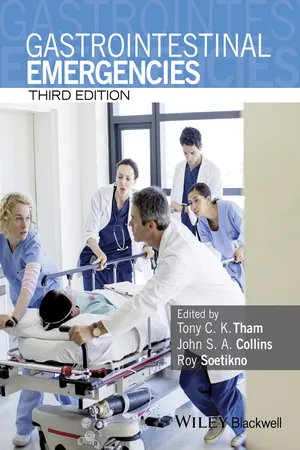
Gastrointestinal Emergencies
- English
- ePUB (mobile friendly)
- Available on iOS & Android
Gastrointestinal Emergencies
About this book
Gastrointestinal Emergencies 3E provides practical, up-to-date guidance for gastroenterologists, endoscopists, surgeons, emergency and acute physicians, medical students and trainees managing patients presenting with GI complications and/or emergencies.
Combining a symptom section, a specific conditions section and a section that examines complications (and solutions) of GI procedures, focus throughout is on clear, specific how-to guidance, for use before a procedure or immediately after emergency stabilization. An evidence-based approach to presentation, diagnosis and investigation is utilized throughout.
New to this third edition are several brand new chapters covering various complications of procedures and specific conditions not previously featured, as well as a thorough look at the many diagnostic and therapeutic advances in recent years. In addition, every chapter from the current edition has undergone wholesale revision to ensure it is updated with the very latest in management guidelines and clinical practice. Once again, full range of emergencies encountered in daily clinical practice will be examined, such as acute pancreatitis, esophageal perforation, capsule endoscopy complications, acute appendicitis, and the difficulties after gastrointestinal procedures. International guidelines from the world's key gastroenterology societies will be included in relevant chapters.
Gastrointestinal Emergencies 3E is the definitive reference guide for the management of gastrointestinal emergencies and endoscopic complications, and the perfect accompaniment for the modern-day gastroenterologist, surgeon, emergency and acute physicians.
Every Emergency Department, GI/endoscopy unit, medical/surgical admission unit should keep a copy close at hand for quick reference.
Frequently asked questions
- Essential is ideal for learners and professionals who enjoy exploring a wide range of subjects. Access the Essential Library with 800,000+ trusted titles and best-sellers across business, personal growth, and the humanities. Includes unlimited reading time and Standard Read Aloud voice.
- Complete: Perfect for advanced learners and researchers needing full, unrestricted access. Unlock 1.4M+ books across hundreds of subjects, including academic and specialized titles. The Complete Plan also includes advanced features like Premium Read Aloud and Research Assistant.
Please note we cannot support devices running on iOS 13 and Android 7 or earlier. Learn more about using the app.
Information
SECTION 1
Approach to specific presentations
CHAPTER 1
Approach to dysphagia
Definitions
- oropharyngeal dysphagia, where there is an inability to initiate the swallowing process and may involve disorders of striated muscle. There may be a sensation of solids or liquids left in the pharynx.
- esophageal dysphagia, which involves disorders of the smooth muscle of the esophagus and results in symptoms within seconds of the Initiation of swallowing.
Differential diagnosis
|
|
History and examination
- The patient may complain of nasal regurgitation of liquid, coughing or choking during swallowing or a change in voice character which may indicate nasal speech due to palatal weakness.
- Patients may desc...
Table of contents
- Cover
- Title Page
- Table of Contents
- Notes on contributors
- SECTION 1: Approach to specific presentations
- SECTION 2: Complications of gastrointestinal procedures and therapy
- SECTION 3: Specific conditions
- Index
- End User License Agreement